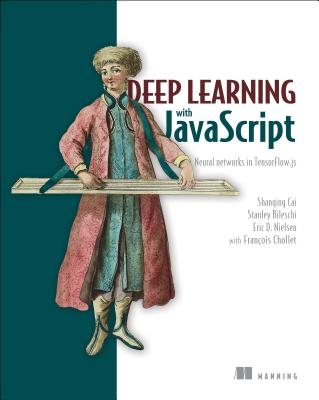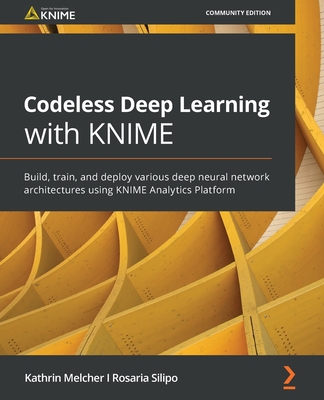Deep Learning for the Life Sciences (Paperback)
暫譯: 生命科學的深度學習 (平裝本)
Bharath Ramsundar , Peter Eastman , Patrick Walters , Vijay Pande
- 出版商: O'Reilly
- 出版日期: 2019-05-14
- 定價: $2,950
- 售價: 8.5 折 $2,508
- 語言: 英文
- 頁數: 238
- 裝訂: Paperback
- ISBN: 1492039837
- ISBN-13: 9781492039839
-
相關分類:
DeepLearning
-
相關翻譯:
深度學習|生命科學應用 (Deep Learning for the Life Sciences) (繁中版)
立即出貨 (庫存 < 4)
買這商品的人也買了...
-
 $3,325The Elements of Statistical Learning: Data Mining, Inference, and Prediction, 2/e (Hardcover)
$3,325The Elements of Statistical Learning: Data Mining, Inference, and Prediction, 2/e (Hardcover) -
 Real-Time Communication with WebRTC: Peer-to-Peer in the Browser (Paperback)
Real-Time Communication with WebRTC: Peer-to-Peer in the Browser (Paperback)$1,100$1,045 -
 $1,872Deep Learning: A Practitioner's Approach (Paperback)
$1,872Deep Learning: A Practitioner's Approach (Paperback) -
 Deep Learning|用 Python 進行深度學習的基礎理論實作
Deep Learning|用 Python 進行深度學習的基礎理論實作$580$458 -
 演算法圖鑑:26種演算法 + 7種資料結構,人工智慧、數據分析、邏輯思考的原理和應用 step by step 全圖解
演算法圖鑑:26種演算法 + 7種資料結構,人工智慧、數據分析、邏輯思考的原理和應用 step by step 全圖解$450$356 -
 為你自己學 Git
為你自己學 Git$500$390 -
 $1,608Mac OS X 技術內幕
$1,608Mac OS X 技術內幕 -
 $1,320Deep Learning with JavaScript: Neural Networks in Tensorflow.Js
$1,320Deep Learning with JavaScript: Neural Networks in Tensorflow.Js -
 雲端深入你我身邊:新一代邊緣運算技術直達
雲端深入你我身邊:新一代邊緣運算技術直達$650$514 -
 機器學習的數學基礎 : AI、深度學習打底必讀
機器學習的數學基礎 : AI、深度學習打底必讀$580$458 -
 特徵工程不再難:資料科學新手也能輕鬆搞定! (Feature Engineering Made Easy: Identify unique features from your dataset in order to build powerful machine learning systems)
特徵工程不再難:資料科學新手也能輕鬆搞定! (Feature Engineering Made Easy: Identify unique features from your dataset in order to build powerful machine learning systems)$520$406 -
 $708Boost 程序庫完全開發指南 ― 深入 C++ ”準”標準庫, 5/e
$708Boost 程序庫完全開發指南 ― 深入 C++ ”準”標準庫, 5/e -
 GAN 對抗式生成網路 (GANs in Action: Deep learning with Generative Adversarial Networks)
GAN 對抗式生成網路 (GANs in Action: Deep learning with Generative Adversarial Networks)$750$593 -
 Codeless Deep Learning with KNIME: Build, train, and deploy various deep neural network architectures using KNIME Analytics Platform
Codeless Deep Learning with KNIME: Build, train, and deploy various deep neural network architectures using KNIME Analytics Platform$1,980$1,881 -
 $709奔跑吧 Linux 內核 (捲1):基礎架構, 2/e
$709奔跑吧 Linux 內核 (捲1):基礎架構, 2/e -
 JavaScript 大全, 7/e (Javascript: The Definitive Guide: Master the World's Most-Used Programming Language, 7/e)
JavaScript 大全, 7/e (Javascript: The Definitive Guide: Master the World's Most-Used Programming Language, 7/e)$1,200$948 -
 $658奔跑吧 Linux 內核入門篇, 2/e
$658奔跑吧 Linux 內核入門篇, 2/e -
 $560奔跑吧 Linux 內核 (捲2):調試與案例分析, 2/e
$560奔跑吧 Linux 內核 (捲2):調試與案例分析, 2/e -
 Python 刷題鍛鍊班:老手都刷過的 50 道程式題, 求職面試最給力 (Python Workout: 50 ten-minute exercises)
Python 刷題鍛鍊班:老手都刷過的 50 道程式題, 求職面試最給力 (Python Workout: 50 ten-minute exercises)$480$408 -
 資料科學的建模基礎 : 別急著 coding!你知道模型的陷阱嗎?
資料科學的建模基礎 : 別急著 coding!你知道模型的陷阱嗎?$599$509 -
 $690MATLAB 2020 信號處理從入門到精通
$690MATLAB 2020 信號處理從入門到精通 -
 資料科學的統計實務 : 探索資料本質、扎實解讀數據,才是機器學習成功建模的第一步
資料科學的統計實務 : 探索資料本質、扎實解讀數據,才是機器學習成功建模的第一步$599$473 -
 既會用也了解:最新一代 5G 核心技術加強版 (過版書特價)
既會用也了解:最新一代 5G 核心技術加強版 (過版書特價)$1,200$840 -
 Node.js 量化投資全攻略:從資料收集到自動化交易系統建構實戰(iThome鐵人賽系列書)【軟精裝】
Node.js 量化投資全攻略:從資料收集到自動化交易系統建構實戰(iThome鐵人賽系列書)【軟精裝】$760$593 -
 跟 NVIDIA 學深度學習!從基本神經網路到 ......、GPT、BERT...,紮穩機器視覺與大型語言模型 (LLM) 的建模基礎
跟 NVIDIA 學深度學習!從基本神經網路到 ......、GPT、BERT...,紮穩機器視覺與大型語言模型 (LLM) 的建模基礎$880$748
相關主題
商品描述
Deep learning has already achieved remarkable results in many fields. Now it’s making waves throughout the sciences broadly and the life sciences in particular. This practical book teaches developers and scientists how to use deep learning for genomics, chemistry, biophysics, microscopy, medical analysis, and other fields.
Ideal for practicing developers and scientists ready to apply their skills to scientific applications such as biology, genetics, and drug discovery, this book introduces several deep network primitives. You’ll follow a case study on the problem of designing new therapeutics that ties together physics, chemistry, biology, and medicine—an example that represents one of science’s greatest challenges.
- Learn the basics of performing machine learning on molecular data
- Understand why deep learning is a powerful tool for genetics and genomics
- Apply deep learning to understand biophysical systems
- Get a brief introduction to machine learning with DeepChem
- Use deep learning to analyze microscopic images
- Analyze medical scans using deep learning techniques
- Learn about variational autoencoders and generative adversarial networks
- Interpret what your model is doing and how it’s working
商品描述(中文翻譯)
深度學習在許多領域已經取得了顯著的成果。現在,它在科學界廣泛引起了關注,尤其是在生命科學領域。本書實用地教導開發者和科學家如何將深度學習應用於基因組學、化學、生物物理學、顯微鏡學、醫學分析及其他領域。
本書非常適合準備將其技能應用於生物學、遺傳學和藥物發現等科學應用的開發者和科學家,介紹了幾個深度網絡原語。您將跟隨一個案例研究,探討設計新療法的問題,這個問題將物理學、化學、生物學和醫學聯繫在一起,這是一個代表科學最大挑戰的例子。
- 學習在分子數據上執行機器學習的基本知識
- 理解為什麼深度學習是遺傳學和基因組學的強大工具
- 應用深度學習來理解生物物理系統
- 簡要介紹使用 DeepChem 的機器學習
- 使用深度學習分析顯微圖像
- 使用深度學習技術分析醫學掃描
- 了解變分自編碼器和生成對抗網絡
- 解釋您的模型在做什麼以及它是如何工作的
作者簡介
Bharath Ramsundar is the co-founder and CTO of Computable, a blockchain company working to build a decentralized data marketplace for AI applications. Bharath is also the lead developer and creator of DeepChem.io, an open source package founded on Tensorflow that aims to democratize the use of deep-learning in drug-discovery, and the co-creator of the moleculenet.ai benchmark suite.
Bharath Ramsundar received a BA and BS from UC Berkeley in EECS and Mathematics and was valedictorian of his graduating class in mathematics. He recently finished his PhD in computer science at Stanford University (all but dissertation) with the Pande group, supported by a Hertz Fellowship, the most selective graduate fellowship in the sciences.
Peter Eastman develops software for computational chemistry and biology in the Bioengineering Department at Stanford University.
Pat Walters heads the Computation & Informatics group at Relay Therapeutics. His group focuses on novel applications of computational methods that drive drug discovery.
Vijay Pande, PhD is a general partner at Andreessen Horowitz where he leads the firm’s investments in companies at the cross section of biology and computer science including areas such as the application of computation, Machine Learning, and Artificial Intelligence broadly into Biology and Healthcare as well as the application of novel transformative scientific advances. He is also an Adjunct Professor of Bioengineering at Stanford, where he advises research at the intersection of Computer Science and Biology, pioneering computational methods and their application to medicine and biology, resulting in over 200 publications, two patents and two novel drug treatments.
As an entrepreneur at the convergence of biology and computer science, Vijay is the founder of the Folding@Home Distributed Computing Project for disease research that pushes the boundaries of the development and application of computer science techniques (such as distributed systems, machine learning, and exotic computer architectures) into biology and medicine, in both fundamental research as well as the development of new therapeutics. Also during his time at Stanford, Vijay co-founded Globavir Biosciences, where he translated his research advances at Stanford and Folding@Home into a successful startup, discovering cures for Dengue Fever and Ebola. In his teens, he was the first employee at video game startup Naughty Dog Software, maker of Crash Bandicoot.
作者簡介(中文翻譯)
Bharath Ramsundar 是 Computable 的共同創辦人及首席技術官,這是一家致力於為 AI 應用建立去中心化數據市場的區塊鏈公司。Bharath 同時也是 DeepChem.io 的首席開發者和創建者,這是一個基於 Tensorflow 的開源套件,旨在使深度學習在藥物發現中的使用民主化,並且是 moleculenet.ai 基準套件的共同創建者。
Bharath Ramsundar 在加州大學伯克利分校獲得了電機與計算機科學(EECS)及數學的學士學位,並且在數學畢業班中獲得了優等生的榮譽。他最近在史丹佛大學完成了計算機科學的博士學位(僅剩論文),並在 Pande 小組的支持下獲得了赫茲獎學金,這是科學領域中最具選擇性的研究生獎學金。
Peter Eastman 在史丹佛大學生物工程系開發計算化學和生物學的軟體。
Pat Walters 領導 Relay Therapeutics 的計算與資訊組。他的團隊專注於推動藥物發現的計算方法的新應用。
Vijay Pande 博士是 Andreessen Horowitz 的普通合夥人,負責該公司在生物學和計算機科學交叉領域的投資,包括計算應用、機器學習和人工智慧在生物學和醫療保健中的廣泛應用,以及新型變革性科學進展的應用。他同時也是史丹佛大學生物工程的兼任教授,指導計算機科學與生物學交叉領域的研究,開創計算方法及其在醫學和生物學中的應用,並取得超過 200 篇出版物、兩項專利和兩種新藥治療。
作為一名位於生物學和計算機科學交匯處的企業家,Vijay 創立了 Folding@Home 分散式計算項目,專注於疾病研究,推動計算機科學技術(如分散式系統、機器學習和特殊計算架構)在生物學和醫學中的發展和應用,涵蓋基礎研究及新療法的開發。在史丹佛大學期間,Vijay 共同創立了 Globavir Biosciences,將他在史丹佛和 Folding@Home 的研究進展轉化為成功的初創公司,發現了登革熱和埃博拉的治療方法。在青少年時期,他是視頻遊戲初創公司 Naughty Dog Software 的第一位員工,該公司是《Crash Bandicoot》的製作商。











